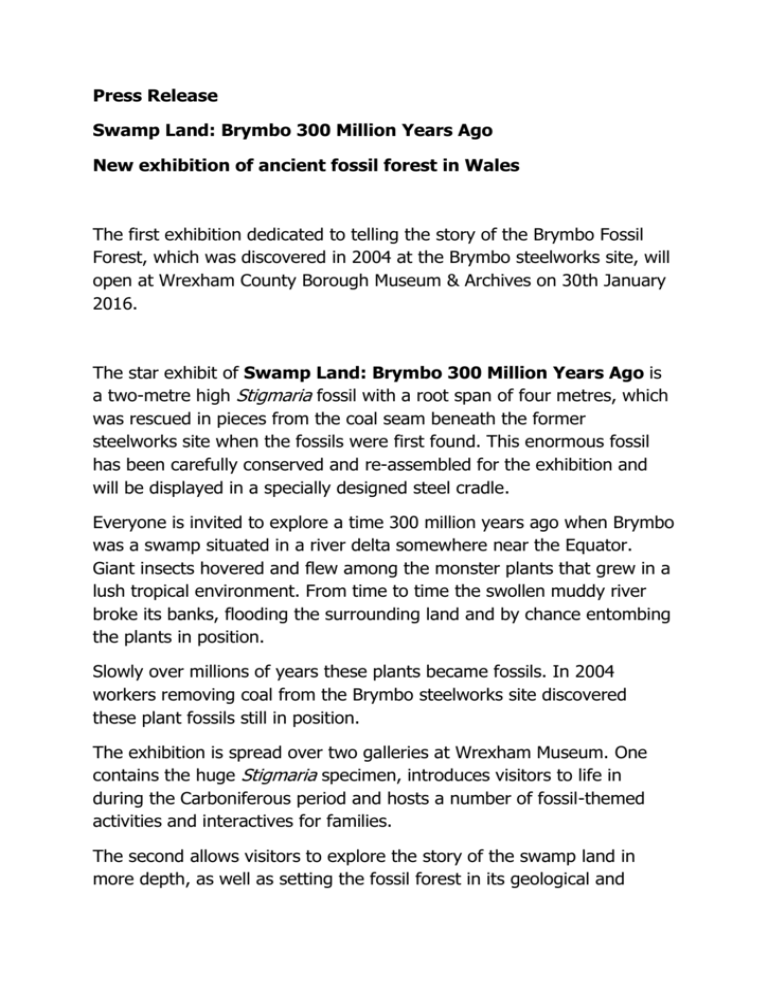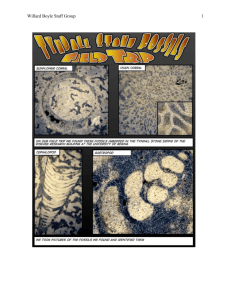here - Geologists` Association
advertisement

Press Release Swamp Land: Brymbo 300 Million Years Ago New exhibition of ancient fossil forest in Wales The first exhibition dedicated to telling the story of the Brymbo Fossil Forest, which was discovered in 2004 at the Brymbo steelworks site, will open at Wrexham County Borough Museum & Archives on 30th January 2016. The star exhibit of Swamp Land: Brymbo 300 Million Years Ago is a two-metre high Stigmaria fossil with a root span of four metres, which was rescued in pieces from the coal seam beneath the former steelworks site when the fossils were first found. This enormous fossil has been carefully conserved and re-assembled for the exhibition and will be displayed in a specially designed steel cradle. Everyone is invited to explore a time 300 million years ago when Brymbo was a swamp situated in a river delta somewhere near the Equator. Giant insects hovered and flew among the monster plants that grew in a lush tropical environment. From time to time the swollen muddy river broke its banks, flooding the surrounding land and by chance entombing the plants in position. Slowly over millions of years these plants became fossils. In 2004 workers removing coal from the Brymbo steelworks site discovered these plant fossils still in position. The exhibition is spread over two galleries at Wrexham Museum. One contains the huge Stigmaria specimen, introduces visitors to life in during the Carboniferous period and hosts a number of fossil-themed activities and interactives for families. The second allows visitors to explore the story of the swamp land in more depth, as well as setting the fossil forest in its geological and historical context and providing extra space to display more of the Brymbo plant fossils. Richard Bevins, Keeper of Natural Sciences, Amgueddfa Cymru – National Museum Wales said: “The Brymbo Fossil Forrest was a significant find for Wales, and indeed the wider scientific world. It has been a privilege for the Museum to work with all the partners involved and to conserve the fossils so that future generations can appreciate and learn from specimens. We care for objects so that not only can they be used for research but also shared with the people of Wales.” Councillor Hugh Jones, Lead Member for Place – Communities & Regeneration, Wrexham County Borough Council, said: “Wrexham Museum would like to thank Amgueddfa Cymru, Brymbo Heritage Group and Brymbo Developments Ltd for their help in making this exhibition a reality. Both the Heritage Group and the Company deserve enormous credit for discovering, preserving and now helping to display this fascinating glimpse of our remote past. The fossil ‘forest’ ranks amongst one of the most important geological discoveries in the country and I look forward to more discoveries being made at the site over the coming years.” Swamp Land: Brymbo 300 Million Years Ago is on show at Wrexham County Borough Museum & Archives until June 4th 2016. Admission is free. For more information contact: Press office contacts (NMW and WCBC). Lleucu Cooke, Communications Officer Amgueddfa Cymru – National Museum Wales 029 2057 3175 lleucu.cooke@museumwales.ac.uk The 'Big Stig' fact sheet - The 'Big Stig' is just over 310 Million years old. It’s not from a tree but from an extinct kind of plant called a Giant Club-moss. (Today’s Club-mosses are only a few centimetres high. Trees didn’t evolve until much later.) - This giant club-moss was killed when a river burst its banks. - These strange plants could grow up to 40 metres tall. They grew in a swamp that stretched for hundreds of miles when what is now Brymbo (and the rest of Wales/UK) was near the Equator. It’s the most complete example of a Stigmaria in the UK. (The scientific name Stigmaria only applies to the root system because the other parts of the plant were discovered as fossils at separate times and were only identified as being from the same plant much later.) Before conservation the 'Big Stig' was in 86 pieces and now it’s a three-dimensional jigsaw of just 12 pieces. Each trunk section weighs about a quarter of a ton. It’s not a fossil you can take home in your pocket! The root weighs considerably more. - Scientists call these plants 'Arborescent Lycopsids'! - There may be more 'Big Stigs' on the Brymbo Fossil Forest site. It took over sixty days to conserve 'Big Stig', reassemble the parts, and make the bespoke cradle that supports the one ton fossil when it is on display.







